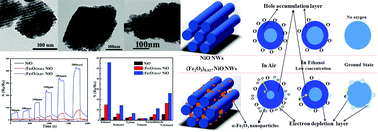The highly improved gas-sensing performance of α-Fe2O3-decorated NiO nanowires and the interfacial effect of p–n heterojunctions
Abstract
Mesoporous n-type α-Fe2O3-decorated p-type NiO nanowires (NiO NWs) were synthesized via a two-step nanocasting method, and then the influence of the heterogeneous α-Fe2O3 decoration on the components, microstructure and gas-sensing performance of the NiO NWs was discussed in detail. All prepared samples with a uniform diameter present similar mesoporous microstructures. No α-Fe2O3 nanoparticles are observed on the surfaces of the NiO NWs and α-Fe2O3 nanoparticles are found to exist in the mesopores between nanowires. Decoration with α-Fe2O3 nanoparticles greatly affects the ethanol gas response. The response of the (Fe2O3)0.027NiO NW sensor is about 13 times that of a pristine NiO NW sensor toward 100 ppm ethanol gas at 280 °C. The (Fe2O3)0.027NiO NW sensor presents an excellent gas response, and good reproducibility and selectivity due to the α-Fe2O3 nanoparticles. The formation of α-Fe2O3/NiO p–n heterojunctions at the interfaces of the α-Fe2O3 nanoparticles and NiO NWs significantly affects electron transitions in air and ethanol gas. The small α-Fe2O3 nanoparticles (2–3.85 nm) are entirely within the electron depletion region in different gases due to the interfacial effects of p–n heterojunctions, leading to decreased resistance in air and increased resistance in ethanol gas.



 Please wait while we load your content...
Please wait while we load your content...